MyDigitalSSD SMART & BP3 mSATA SSD Review
by Kristian Vättö on January 22, 2013 1:24 PM ESTAnandTech Storage Bench 2011
Last year we introduced our AnandTech Storage Bench, a suite of benchmarks that took traces of real OS/application usage and played them back in a repeatable manner. Anand assembled the traces out of frustration with the majority of what we have today in terms of SSD benchmarks.
Although the AnandTech Storage Bench tests did a good job of characterizing SSD performance, they weren't stressful enough. All of the tests performed less than 10GB of reads/writes and typically involved only 4GB of writes specifically. That's not even enough exceed the spare area on most SSDs. Most canned SSD benchmarks don't even come close to writing a single gigabyte of data, but that doesn't mean that simply writing 4GB is acceptable.
Originally we kept the benchmarks short enough that they wouldn't be a burden to run (~30 minutes) but long enough that they were representative of what a power user might do with their system. Later, however, we created what we refer to as the Mother of All SSD Benchmarks (MOASB). Rather than only writing 4GB of data to the drive, this benchmark writes 106.32GB. This represents the load you'd put on a drive after nearly two weeks of constant usage. And it takes a long time to run.
1) The MOASB, officially called AnandTech Storage Bench 2011—Heavy Workload, mainly focuses on the times when your I/O activity is the highest. There is a lot of downloading and application installing that happens during the course of this test. Our thinking was that it's during application installs, file copies, downloading, and multitasking with all of this that you can really notice performance differences between drives.
2) We tried to cover as many bases as possible with the software incorporated into this test. There's a lot of photo editing in Photoshop, HTML editing in Dreamweaver, web browsing, game playing/level loading (Starcraft II and WoW are both a part of the test), as well as general use stuff (application installing, virus scanning). We included a large amount of email downloading, document creation, and editing as well. To top it all off we even use Visual Studio 2008 to build Chromium during the test.
The test has 2,168,893 read operations and 1,783,447 write operations. The IO breakdown is as follows:
| AnandTech Storage Bench 2011—Heavy Workload IO Breakdown | ||||
| IO Size | % of Total | |||
| 4KB | 28% | |||
| 16KB | 10% | |||
| 32KB | 10% | |||
| 64KB | 4% | |||
Only 42% of all operations are sequential; the rest ranges from pseudo to fully random (with most falling in the pseudo-random category). Average queue depth is 4.625 IOs, with 59% of operations taking place in an IO queue of 1.
Many of you have asked for a better way to really characterize performance. Simply looking at IOPS doesn't really say much. As a result we're going to be presenting Storage Bench 2011 data in a slightly different way. We'll have performance represented as Average MB/s, with higher numbers being better. At the same time we'll be reporting how long the SSD was busy while running this test. These disk busy graphs will show you exactly how much time was shaved off by using a faster drive vs. a slower one during the course of this test. Finally, we will also break out performance into reads, writes, and combined. The reason we do this is to help balance out the fact that this test is unusually write intensive, which can often hide the benefits of a drive with good read performance.
There's also a new light workload for 2011. This is a far more reasonable, typical every day use case benchmark. It has lots of web browsing, photo editing (but with a greater focus on photo consumption), video playback, as well as some application installs and gaming. This test isn't nearly as write intensive as the MOASB but it's still multiple times more write intensive than what we were running last year.
We don't believe that these two benchmarks alone are enough to characterize the performance of a drive, but hopefully along with the rest of our tests they will help provide a better idea. The testbed for Storage Bench 2011 has changed as well. We're now using a Sandy Bridge platform with full 6Gbps support for these tests.
AnandTech Storage Bench 2011—Heavy Workload
We'll start out by looking at average data rate throughout our new heavy workload test:
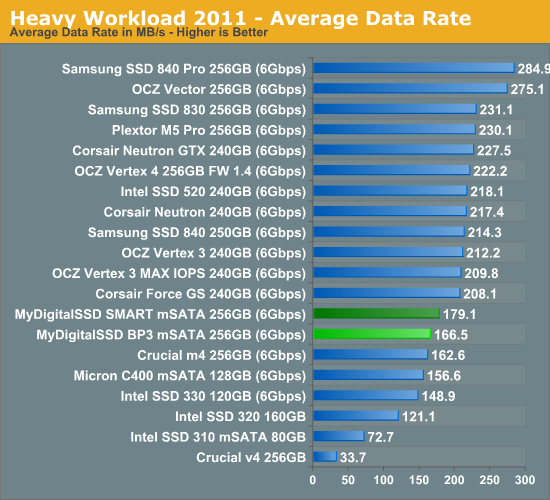
Despite the limitations of the PS3108 controller, the BP3 performs decently. The gap between it and the SandForce based SMART is only 12.6MB/s in our Heavy suite. Neither of the drives is able to keep up with standard 2.5" SSDs, but it's worthwhile to note that some of this is due to the limited NAND bandwidth (4 packages versus 8-16 in 2.5" SSDs).

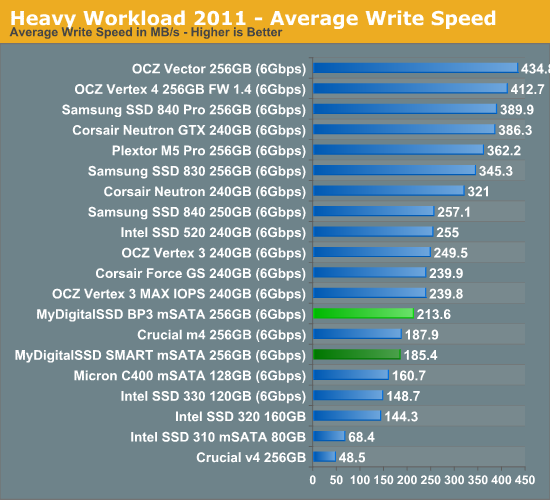
The next three charts just represent the same data, but in a different manner. Instead of looking at average data rate, we're looking at how long the disk was busy for during this entire test. Note that disk busy time excludes any and all idles, this is just how long the SSD was busy doing something:
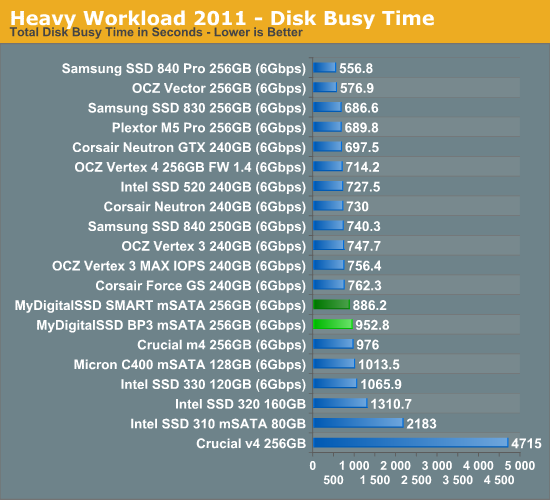
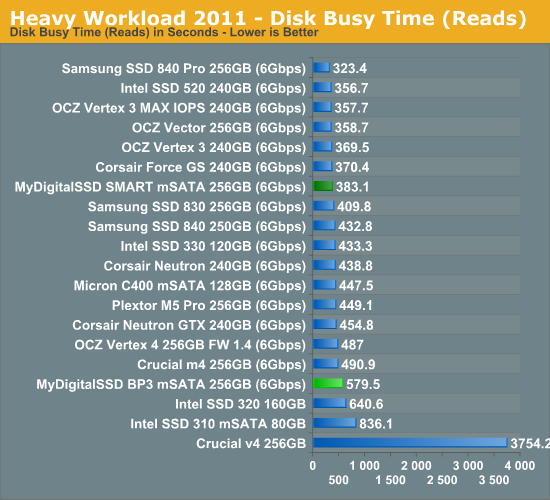
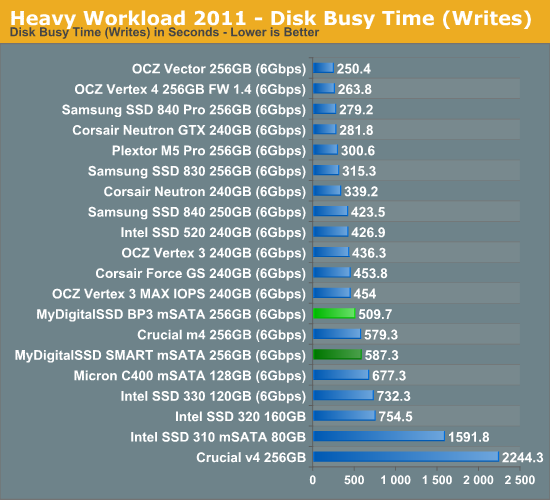










49 Comments
View All Comments
Flunk - Tuesday, January 22, 2013 - link
DIY upgrades are really what mSATA SSDs are for. They really don't make sense on the desktop. But I would argue that the performance desktop is just as much a niche market. As long as a market exists these products will too.As for me I have a ADATA SX300 mSATA SSD (256GB) along with a 750GB HD in an Alienware m14x R2. Great way to get more storage into a system that couldn't fit another 2.5" drive without losing the optical bay. mSATA SSDs are very convenient now.
Hopefully everyone will standardize on one of the new PCI-E based SSD specs, but that's all future technology for now.
Kraszmyl - Tuesday, January 22, 2013 - link
Considering almost all of dell and lenovos machines that came out recently have msata slots i wouldnt exactly call them rare and im sure the ultrabook people will move to them too.That being said i would like to see them on more itx and micro atx boards.
ssj3gohan - Tuesday, January 22, 2013 - link
Yeah, I'm super-happy with the mSATA slots on recent Intel mITX and mATX motherboards. It may seem like a small deal to some, but mSATA saves a lot of space and IMO more importantly: a mess of wires.I've been able to build very capable systems with no wires blocking airflow and getting in the way at all in arguably the smallest enclosure commercially available, the mini-box M350. All because of motherboards supporting 19V input and mSATA.
JarredWalton - Tuesday, January 22, 2013 - link
mSATA is already being phased out for NGFF/M.2, so I don't expect a lot of support for mSATA going forward. Apple, ASUS, and others already skipped mSATA to go their own routes, indicating the perceived issues from those manufacturers.M.2 will hopefully bring more standardization and acceptance, and it would be great if ASUS, Apple, etc. used M.2 instead of proprietary connectors -- there are quite a few people that are ticked that UX21A/UX31A had review samples with SF-2281 ADATA drives and then shipping consumer models typically (maybe even only?) used SanDisk U100. Because of the proprietary connector, there's basically no way to upgrade from the U100.
ssj3gohan - Wednesday, January 23, 2013 - link
I don't necessarily care whether it's NGFF or mSATA, as long as it's a cableless solution and there's sufficient availability of drives. Right now mSATA has good market penetration; I haven't had any problems sourcing tens of crucial m4 mSATA drives, even the most exotic 256GB variant. Same goes for myDigitalSSD's earlier offerings, which seemed to be in stock all the time (very short lead times).As soon as NGFF is used or can be used on the desktop I'm perfectly happy using those as the ubiquitous boot drive.
Voldenuit - Tuesday, January 22, 2013 - link
Exactly!mSATA SSDs are a good way to add performance and capacity to a (compatible) laptop. And doing it aftermarket keeps the OEMs from ripping off the customer with their exorbitant upgrade prices.
I added a 128 GB crucial m4 SSD to my wife's Thinkpad X230T laptop to complement the existing 500GB hdd. It was far cheaper than configuring it with a 2.5" SSD from lenovo (there was no option on their configurator to outlay the laptop with a mSATA SSD instead) and far more versatile, as the single-spindle X230T is now transformed into effectively a 2-spindle machine (still no DVD drive, but we have an ultrabase mobile dock for that).
I wouldn't buy a modern laptop that doesn't have an mSATA slot today.
cmikeh2 - Tuesday, January 22, 2013 - link
While traditional forms of computing may not necessitate the smaller form factor future products like Intel's Next Unit of Computing with its 4 x 4 inch mobo only supports mSATA. Work in this form factor will allow products like NUC to be worthwhile.digitalzombie - Tuesday, January 22, 2013 - link
"the potential to grap a large share"grap -> grab
Kristian Vättö - Tuesday, January 22, 2013 - link
Thanks for the heads up, fixed! :-)kesh - Tuesday, January 22, 2013 - link
Just a guess, but wouldn't there be a market for mSATA in embedded computing world?I have an ongoing project of turning a broken (slim) CD player to a digital audio player, which has been going slow over a last few years, and when I first saw mSATA, I immediately thought it as the perfect storage solution for my project.